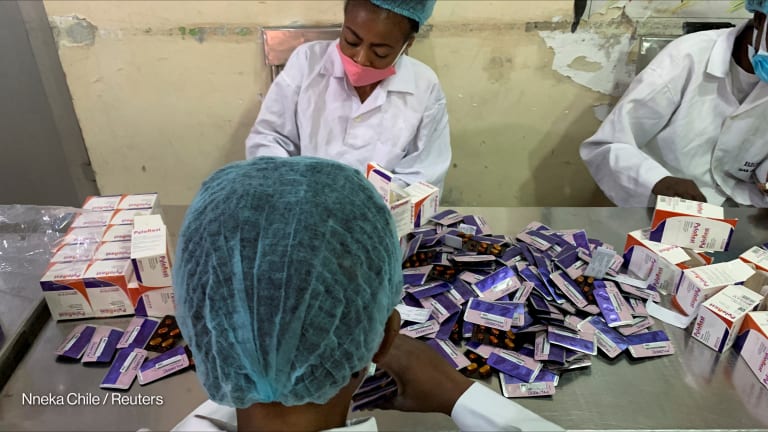Turning health clinics into appealing customers to the energy sector
Off-grid renewable energy is seen as a powerful way to electrify the thousands of health facilities that don't have electricity. But health facilities aren't seen as a reliable customer.
A health facility without electricity can’t refrigerate vaccines or blood. Night-time deliveries of babies might only be possible by the light of a mobile phone guiding the surgeon, and some equipment don’t function in the operating room. Those are the realities facing thousands of health facilities globally that lack electricity — many of which are in remote areas. An estimated 100,000 public health care facilities don’t have access to reliable electricity in sub-Saharan Africa – undermining their ability to provide patients with quality care. These facilities are considered risky customers to energy companies, and not enough is put into the maintenance of renewable energy systems that are installed, curbing their sustainability, according to delegates at the Sustainable Energy for All Forum in Kigali last week. In Uganda, for example, 63% of the health facilities, particularly in remote areas, do not have access to electricity, said Dr. Brian Isabirye, the commissioner of renewable energy at the Ministry of Energy and Mineral Development in Uganda. “You survive by luck,” he said. “When you need to do an operation at night, you either have a torch in your mouth, or you have to wait for daylight to do the operation.” Some are powered by diesel generators, which are expensive to fuel, pollute the air, and are vulnerable to fuel shortages. Because of this, there is a strong need for decentralized, renewable energy solutions, said Maria Neira, director of the department of public health and environment at the World Health Organization. “We need to accelerate off-grid solar panels,” Neira said. But even when off-grid energy companies provide energy in remote areas, health facilities are often seen as customers likely to default on payments, according to the delegates. “The private sector system is serving households; its serving enterprises; its serving farmers. Why can't they serve health institutions and schools? The issue here is that they cannot do it because they don't think they will be paid,” said Dana Rysankova, global lead for energy access at the World Bank's Energy and Extractives Global Practice. Another issue is that financing is not used in an efficient or sustainable way, Rysankova said. Donors finance installations of solar systems for the roof of a clinic and “a few years after the battery fails, no one replaces it. Someone then puts another system and someone puts another system.” “All of us need to think a little bit about the mentality change, especially among the donors, because quite frankly, it’s just much easier to finance the purchase and installation of the solar systems,” Rysankova said, adding that instead, the focus should be on sustainable service which includes contracts for maintenance. In one of the World Bank’s projects in Haiti, the government and its development partners have given concessions to minigrid developers to electrify rural towns. “But often, these connections didn't include the health clinics, because it was not a viable client for those mini grid companies,” Rysankova said. Because of this, the World Bank galvanized additional funding for minigrid developers, which in turn had to commit to servicing these facilities over the lifetime of their concessions, so about 20 years. In Burundi, the bank has a project that involves results-based financing for the health sector, which integrates the operation and maintenance for solar systems into the arrangements. “We are trying to solve this payment issue. Can we work with the governments to set up a payment mechanism, and then maybe we can come as the World Bank Group with some kind of guarantee mechanism that will ensure that this payment will be done?” Rysankova said. “Some sort of guarantee is, of course, what most energy companies want to get,” said Mark Carrato, coordinator of the U.S. Agency for International Development’s Power Africa. In April, Power Africa launched the Healthcare Electrification and Telecommunications Alliance. Power Africa has learned from its projects in the health sector that bundled service delivery is critical and that the private sector has to play a key role in energy delivery, Carrato said “Private sector has to be the solution here, but not the only solution,” Carrato said, adding that the public and private sectors will work together, with the public sector providing subsidies and working to catalyze private investment without crowding out the private sector. “Maybe it takes a while for the market to catch up. Prices will come down on inputs,” he said. “The private sector will be attracted when there's a business model.”
A health facility without electricity can’t refrigerate vaccines or blood. Night-time deliveries of babies might only be possible by the light of a mobile phone guiding the surgeon, and some equipment don’t function in the operating room. Those are the realities facing thousands of health facilities globally that lack electricity — many of which are in remote areas.
An estimated 100,000 public health care facilities don’t have access to reliable electricity in sub-Saharan Africa – undermining their ability to provide patients with quality care.
These facilities are considered risky customers to energy companies, and not enough is put into the maintenance of renewable energy systems that are installed, curbing their sustainability, according to delegates at the Sustainable Energy for All Forum in Kigali last week.
This story is forDevex Promembers
Unlock this story now with a 15-day free trial of Devex Pro.
With a Devex Pro subscription you'll get access to deeper analysis and exclusive insights from our reporters and analysts.
Start my free trialRequest a group subscription Printing articles to share with others is a breach of our terms and conditions and copyright policy. Please use the sharing options on the left side of the article. Devex Pro members may share up to 10 articles per month using the Pro share tool ( ).
Sara Jerving is a Senior Reporter at Devex, where she covers global health. Her work has appeared in The New York Times, the Los Angeles Times, The Wall Street Journal, VICE News, and Bloomberg News among others. Sara holds a master's degree from Columbia University Graduate School of Journalism where she was a Lorana Sullivan fellow. She was a finalist for One World Media's Digital Media Award in 2021; a finalist for the Livingston Award for Young Journalists in 2018; and she was part of a VICE News Tonight on HBO team that received an Emmy nomination in 2018. She received the Philip Greer Memorial Award from Columbia University Graduate School of Journalism in 2014.








